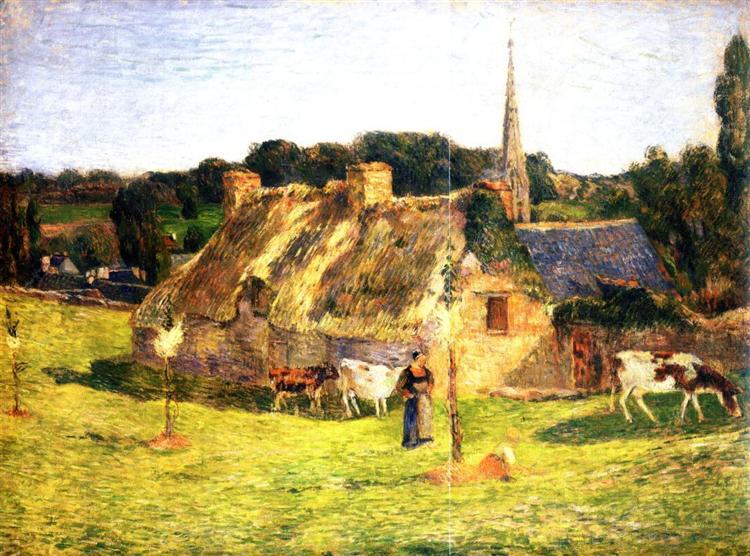Description
In "The Field of Lollichon and the Church of Pont-Aven", painted in 1886, Paul Gauguin invites us to enter a landscape that transcends the merely representative, becoming a testimony to his aesthetic and symbolic quest. This work belongs to a crucial phase in the artist's evolution, when he began to move away from realism and experiment with symbolism and the use of color, which laid the foundations for post-impressionism.
The composition of the work is notable for its balanced structure, in which the church of Pont-Aven occupies a prominent place in the background, serving as a visual and spiritual anchor. The building, which is represented with a simplification of forms that gives it an almost architectural character, stands in front of a vibrant landscape where the blue of the sky contrasts with the warm tones of the earth and the surrounding vegetation. The use of straight lines and geometric shapes suggests a search for order and stability in the painting, traits that attended to Gauguin's artistic concerns at the time.
One of the most intriguing aspects is the treatment of colour. The countryside is presented in a palette of yellow and greenish tones, in an application of almost flat brushstrokes that anticipate the innovations of Fauvism. This colouristic approach not only seeks to portray visual reality, but also suggests an emotion inherent in the landscape, creating an atmosphere of calm and contemplation. The contrast between the colours delights the eye and provides a sense of depth on the visual plane; the sky, an intense blue, stretches above the land, while the clouds are a pure and dynamic white, bringing an ethereal energy to the scene.
Although there are no directly visible human figures, the work is not devoid of an almost spiritual presence, as the church becomes a symbol of the community, an eloquent reminder of life in Pont-Aven. Its active absence of human characters can be interpreted as Gauguin's commentary on the relationship between man, nature and the divine, suggesting that the essence of cultural and social life lies as much in the visible as in the invisible.
This work also reflects Gauguin's personal and artistic context during his time in Brittany, where he sought a deeper connection with rural life and traditional values. In this region, the rich local culture and the beauty of the natural landscape intertwined, inspiring Gauguin to explore not only form, but also colour and emotion. "The Field of Lollichon and the Church of Pont-Aven" can therefore be seen as a bridge to his next journey towards the more radical symbolism he would explore in his later works, where reality is transformed into a vehicle for introspective and spiritual experiences.
Examining this painting, one can see how Gauguin initiated a transformation in visual discourse, which foreshadowed avant-garde movements of the 20th century. The landscape of Pont-Aven is not just a setting, but a meditation on identity, spirituality and human experience, showcasing art's ability to transcend its time and become a window into the viewer's soul. Thus, "The Field of Lollichon and the Church of Pont-Aven" stands not only as a masterpiece in Gauguin's career, but also as a milestone in the history of modern art, which continues to resonate in the contemporary exploration of form and color.
KUADROS ©, a famous painting on your wall.
Hand-made oil painting reproductions, with the quality of professional artists and the distinctive seal of KUADROS ©.
Painting reproduction service with satisfaction guarantee. If you are not completely satisfied with the replica of your painting, we will refund 100% of your money.

